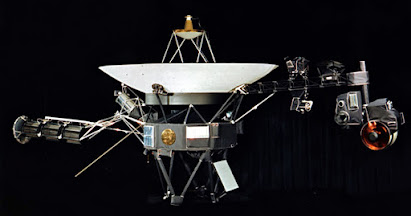Hello guys welcome again. In today’s post we are going to talk about the first interstellar traveler and the farthest man-made objects from earth voyager-1 and voyager-2.
These satellites are launched to explore the solar system. It has golden record which contains very interesting information about earth which will help other civilizations to know about earth if it found by aliens.
Voyager 2 launched 16 days before voyager 1 on 20 August 1977.Voyager-1
launched on 5 September 1977 from cape Canaveral, Florida aboard a titan
centaur rocket. Voyager 1 and voyager 2
They gain enough energy to escape from sun gravitational field by the slingshot due to Jupiter and Saturn.
Journey:
Till date both satellites have
explored main planets in solar system like Jupiter, Saturn, Neptune, Uranus with
their 48 moons and specially the rings possessed by Saturn.
Closest encounter of voyager 1 with Jupiter happened on 5 march 1979
following which it encountered several of Jupiter moons like Amalthea, Europa,
Ganymede, Calisto. And it also discovered two new moons Thebe and Metis.
The flyby with Saturn happened in November 1979. During its flyby the
spacecraft photographed Saturn’s moons titan, mimas, Enceladus, Tethys, Dione and
rhea.
During the flyby to Titan, spacecraft discovered some interesting facts
about titian which has increased curiosity among scientists.
Spacecraft found that titan contain 90% nitrogen pressure is about 1.6
and temperature is about -180 degree Celsius. Atmospheric data suggest that
titan is first body in solar system which contain liquid and atmospheric
presence of nitrogen, methane and more complex hydrocarbons indicates that
prebiotic chemical reaction might be possible on titan.
On 14 February voyagers’ cameras were pointed back towards earth and
captured 60 images of earth and planets.
On February 1998 voyagers 1 become the most distant man-made object at
distance of 69.4 AU from sun.
In August 2012, Voyager 1 became the first spacecraft to cross into interstellar space.
Planetary tours:
Jupiter: closest approach to Jupiter occurred on march 5, 1979 by voyager 1 and 8 July, 1979 for voyager 2.
Saturn: closest approach on 12 November 12,
1980 for voyager 1 and 25 august 1981 for voyager 2.
Uranus: closest approach occurred on 24
January ,1986 by voyager 2
Neptune: closest approach occurred on 25 august ,1989 by
voyager 2
Golden record:
Interesting thing which spacecraft brought from earth is golden record.
Both voyager’s spacecrafts carry greetings from humans to extra-terrestrial beings
who happen to find them. This is phonographic record with 12-inch gold plated
copper disk which contain sounds and images from earth. Also, it contains
spoken greeting in different 55 languages.
Design of golden record:
1. The contents of record were selected by NASA committee chaired by
Dr.Sagan.
2. The records cover is aluminum and electroplated upon its ultra-pure sample of the isotope uranium-238.
Urenium-238 has half-life about 4.468 billion years.
Some interesting facts about golden record:
1.golden record are highly likely to survive at least partially intact
for a span of over 5 billion years.
2.golden record consists 115 analog encoded photographs, greeting in 55
languages, a 12-minute montage of sounds on earth. And 90 minutes of music.
Present status:
1.In
April 2020, voyager 1 was at distance of 22.3 billion kilometers from sun. and
escaping the solar system at a speed about 3.6 AU (astronomical unit) per year.
2.voyager
2 was at distance of 18,5 billion km and escaping solar system at a speed of
3.3 AU per year.
Interesting facts about voyager’s spacecrafts:
1.Both
voyagers spacecrafts communicate to earth by radio waves and usually takes 16
hours to reach signal to earth.
So
its enough for today.
Stay
tuned for new interesting content.


